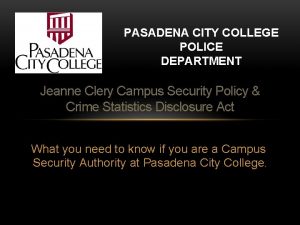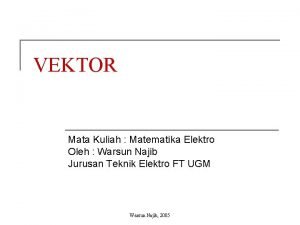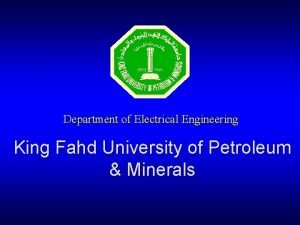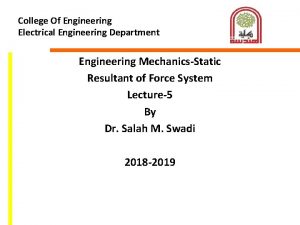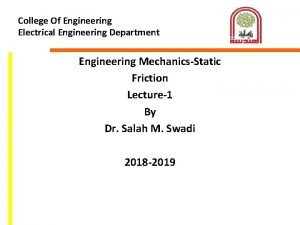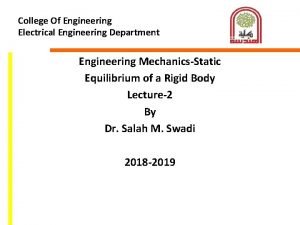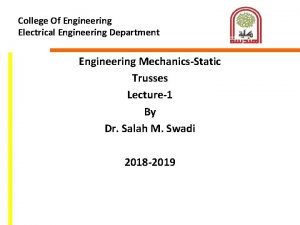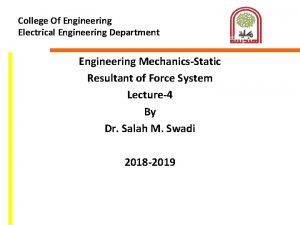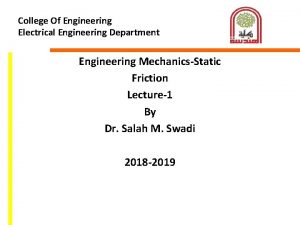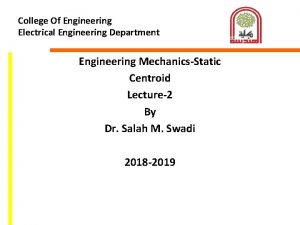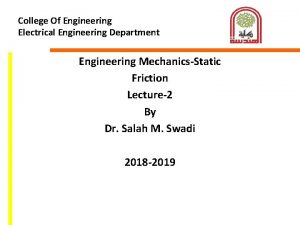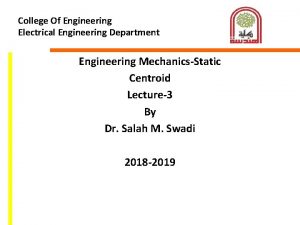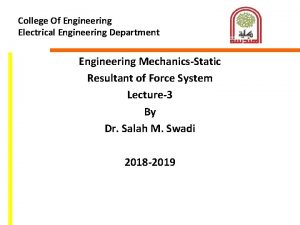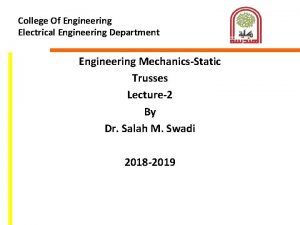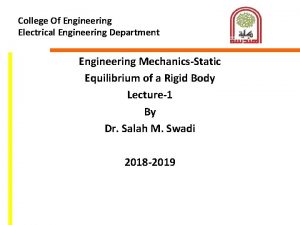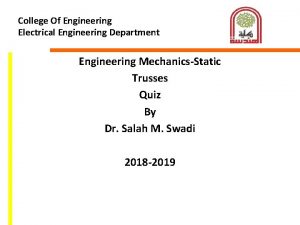College Of Engineering Electrical Engineering Department Engineering MechanicsStatic














- Slides: 14

College Of Engineering Electrical Engineering Department Engineering Mechanics-Static Centroid Lecture-1 By Dr. Salah M. Swadi 2018 -2019

Chapter Objectives • Concept of the center of gravity, center of mass, and the centroid • Determine the location of the center of gravity and centroid for a system of discrete particles and a body of arbitrary shape • Theorems of Pappus and Guldinus • Method for finding the resultant of a general distributed loading

Chapter Outline 1. Center of Gravity and Center of Mass for a System of Particles 2. Composite Bodies 3. Theorems of Pappus and Guldinus 4. Resultants of a General Distributed Loading 5. Fluid Pressure

9. 1 Center of Gravity and Center of Mass for a System of Particles Center of Gravity • Locates the resultant weight of a system of particles • Consider system of n particles fixed within a region of space • The weights of the particles can be replaced by a single (equivalent) resultant weight having defined point G of application

9. 1 Center of Gravity and Center of Mass for a System of Particles Center of Gravity • Resultant weight = total weight of n particles • • Sum of moments of weights of all the particles about x, y, z axes = moment of resultant weight about these axes Summing moments about the x axis, • Summing moments about y axis,

9. 1 Center of Gravity and Center of Mass for a System of Particles Center of Gravity • Although the weights do not produce a moment about z axis, by rotating the coordinate system 90° about x or y axis with the particles fixed in it and summing moments about the x axis, • Generally,

9. 1 Center of Gravity and Center of Mass for a System of Particles Center Mass • Provided acceleration due to gravity g for every particle is constant, then W = mg • • By comparison, the location of the center of gravity coincides with that of center of mass Particles have weight only when under the influence of gravitational attraction, whereas center of mass is independent of gravity

9. 1 Center of Gravity and Center of Mass for a System of Particles Center Mass • A rigid body is composed of an infinite number of particles • Consider arbitrary particle having a weight of d. W

9. 1 Center of Gravity and Center of Mass for a System of Particles Centroid of a Volume • Consider an object subdivided into volume elements d. V, for location of the centroid,

9. 1 Center of Gravity and Center of Mass for a System of Particles Centroid of an Area • For centroid for surface area of an object, such as plate and shell, subdivide the area into differential elements d. A

9. 1 Center of Gravity and Center of Mass for a System of Particles Centroid of a Line • If the geometry of the object takes the form of a line, the balance of moments of differential elements d. L about each of the coordinate system yields

Example 9. 1 Locate the centroid of the rod bent into the shape of a parabolic arc.

Example 9. 1 Differential element Located on the curve at the arbitrary point (x, y) Area and Moment Arms For differential length of the element d. L Since x = y 2 and then dx/dy = 2 y The centroid is located at

Example 9. 1 Integrations
 Electrical engineering department
Electrical engineering department Tum department of electrical and computer engineering
Tum department of electrical and computer engineering Ucla electrical engineering
Ucla electrical engineering Pasadena city college police department
Pasadena city college police department Elektro vektor
Elektro vektor George washington university electrical engineering
George washington university electrical engineering Tel aviv university electrical engineering
Tel aviv university electrical engineering Northwestern computer science department
Northwestern computer science department Klipsch school of electrical and computer engineering
Klipsch school of electrical and computer engineering Umd ece faculty
Umd ece faculty Estimation and costing electrical
Estimation and costing electrical Electrical engineering environmental issues
Electrical engineering environmental issues Wpi computer science flowchart
Wpi computer science flowchart Electrical engineering presentation
Electrical engineering presentation Kfupm ee faculty
Kfupm ee faculty



